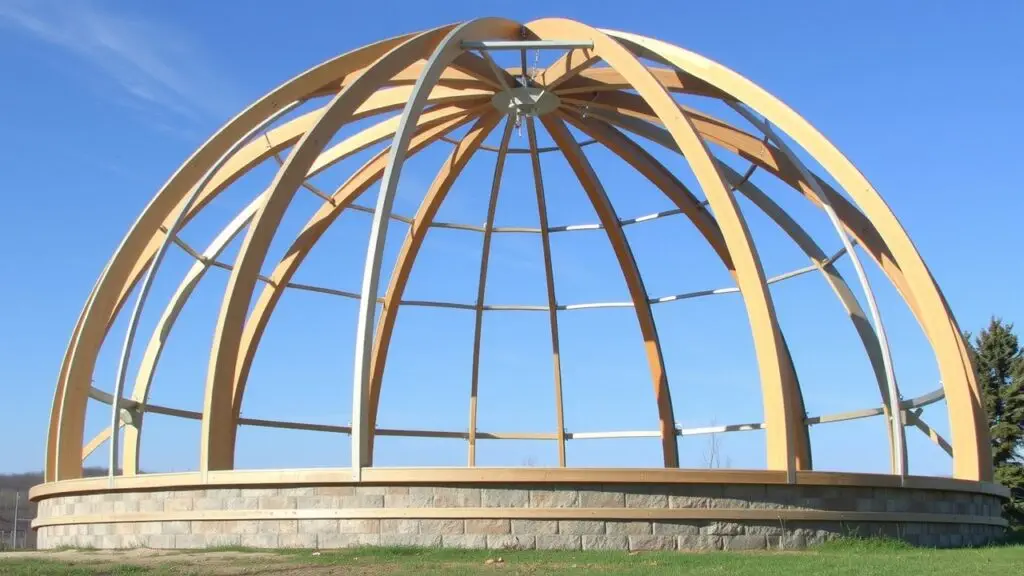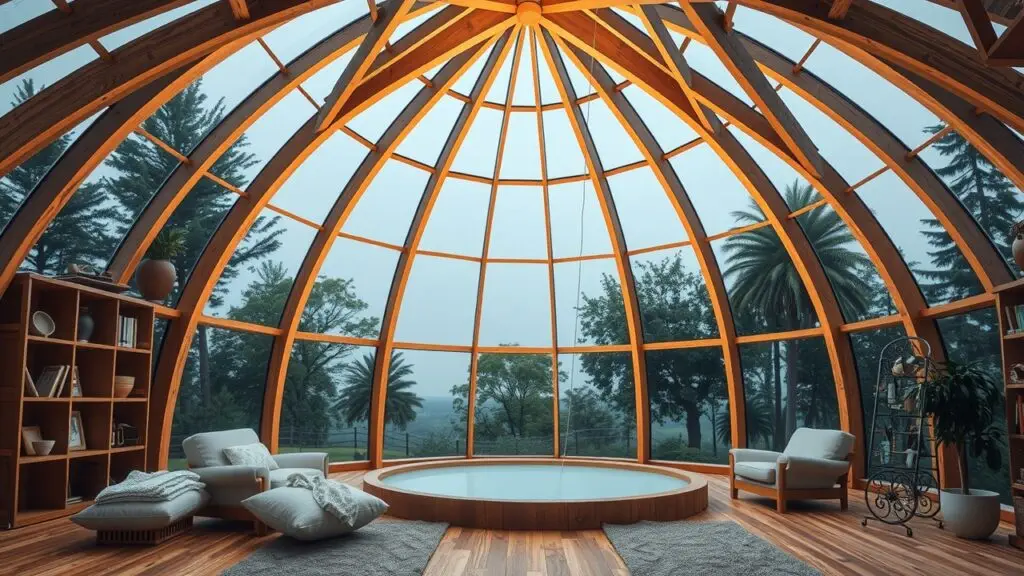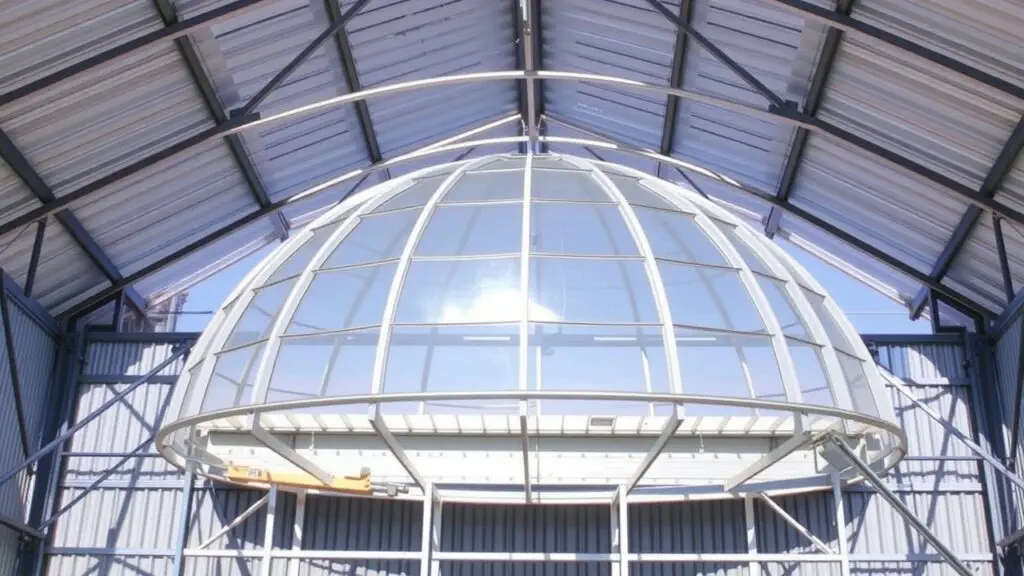Discover the types of dome framing. Choosing the right dome framing depends on budget and aesthetics. Explore geodesic, monolithic, and other methods to build a strong, unique home.
What Is Dome Framing?

Dome framing is a special way to build dome-shaped structures. It uses different frameworks to support the curved shape of the dome. This makes for cool and unique designs. There are several types of dome framing:
- Geodesic Domes: These domes use a network of triangles. This design spreads out stress evenly across the structure, making it strong and material-efficient.
- Monolithic Domes: These are made from one solid shell. They offer great insulation and energy savings because of their smooth surface.
- Timber Dome Frames: These use wood, which looks nice and is light yet strong enough for many uses.
- Metal Dome Frames: Usually made from steel or aluminum, these frames are tough and can handle bad weather, although they may weigh more than wooden ones.
Each type has its own benefits depending on what you need for your project.
Why Are Domes Popular in Construction?
Domes are popular in construction for a few reasons:
- Strength: Their round shape helps them hold heavy loads better than flat roofs.
- Efficiency: The design cuts down wind resistance and helps keep energy costs low by reducing heat loss.
- Aesthetic Appeal: Domes look different and attractive compared to normal building shapes.
Methods like geodesic dome framing show off these benefits with designs that maximize space while staying strong.
Key Factors That Influence the Choice of Dome Framing System
When picking a dome framing system, think about several factors:
- Project Size: Bigger projects might work better with sturdy systems like space frame domes or monolithic constructions, which can cover more area without needing lots of support.
- Location Considerations: Weather conditions, like snow or earthquakes, affect material choice; metal frames might be best in places with rough weather.
- Budget Constraints: Different materials can cost different amounts—timber might be cheaper at first but could need more upkeep later compared to metal options.
- Intended Use: Whether it’s for homes or businesses changes both design choices and what performance levels you need (like insulation).
Knowing these factors helps builders choose the right framework for their projects while keeping safety and durability in mind.
Geodesic Domes – The Engineering Marvel
Geodesic domes are fascinating structures. They have a spherical shape that helps spread stress evenly across the framework. This design is strong and efficient. Triangular strut systems are used in these domes, which boosts their stability and strength. The way these triangles fit together makes geodesic domes lightweight yet very strong. That’s why many people like them for different uses.
What Are Geodesic Domes?
A geodesic dome is made up of a network of triangles. These triangles create a self-supporting structure. This clever design uses less material while still being really strong. The triangular strut systems in geodesic dome framing help share loads well, which means they can handle big forces like wind or snow.
Types of Geodesic Designs
There are different types of geodesic dome designs based on how many triangles they have and their shape:
- Low-Frequency Designs: These have fewer triangles and bigger panels. They are easier to build but use space less efficiently.
- High-Frequency Designs: These have more triangles and smaller panels. They are stronger but need more complicated calculations during planning.
- Full Sphere Configurations: This design forms a complete sphere, offering lots of space with less surface area. They work great for large places like sports arenas or exhibition halls.
- Partial Sphere Configurations: These are often used for homes or greenhouses, where only part of the sphere is built to fit specific needs.
Materials Used in Geodesic Dome Construction
The materials for building geodesic domes change based on what you want to do:
- Timber Frames: A favorite for DIY projects because they’re easy to work with and look nice.
- Steel/Aluminum Frameworks: Commonly used in industrial settings because they last long and stand up well to bad weather.
- Composite Panels: Popular for energy-efficient buildings since they provide good insulation and support.
Each material has its own perks that suit different projects.
Advantages & Disadvantages
Advantages:
- One big plus about geodesic domes is that they’re lightweight but super strong, which makes them easy to move and put together.
- Their smooth shape gives them high wind resistance, keeping them safe even during harsh weather.
- Using materials wisely can lead to cost-effective construction over time because less material often means lower costs overall.
Disadvantages:
- Designing these domes takes some tricky calculations that can be tough at the start.
- Getting the assembly just right is super important; any mistakes could make the structure unstable, which might cause safety problems later on.
Understanding the different types of dome framing helps you see how each one works towards achieving your building goals!
Wooden Domes – Timeless Aesthetic Appeal
How Are Wooden Domes Constructed?
Wooden domes are built using different methods that focus on strength and looks. A common way is timber dome framing. This technique uses laminated wood arches to make a sturdy but light structure. These arches often come from engineered woods like glulam, which is glued laminated timber. Glulam gives strong support while allowing for nice curves.
Another way to build is the stressed skin dome method. Here, thin sheets of plywood work with the frame to create a solid shell. This design improves stability and uses less material, which is great for builders.
The building process usually means putting together prefabricated parts on-site. Sometimes, modular designs help speed up construction. Wooden structures can be customized to meet specific needs, like size and purpose.
Best Wood Materials for Timber Dome Framing
Picking the right materials is key for good timber dome framing. Engineered woods are often the best choice because they are more durable and less likely to warp compared to regular wood. Glulam beams are great since they combine several layers of wood into one strong beam, allowing them to hold more weight.
Cedarwood is also a top pick due to its natural rot resistance and nice look. It’s often used where both looks and function matter. Other rot-resistant options include redwood and treated pine, which handle moisture better than untreated wood.
Using high-quality materials means the dome will last longer and perform well in different weather conditions. This makes them suitable for many projects, from small homes to larger buildings.
Applications & Use Cases
Wooden domes can be used in many different places:
- Small Homes: They allow homeowners to use space wisely while creating striking living areas.
- Gazebos: Perfect for outdoor settings, wooden domes provide shelter while looking good.
- Eco-Friendly Homes: With sustainability in mind, wooden domes fit nicely with green building practices by using renewable resources.
- Yurts: Inspired by traditional homes, modern yurts often use wooden dome designs for comfort and style.
These various uses show how flexible wooden domes can be in both homes and recreational spaces.
Strengths & Weaknesses
Strengths:
A big plus for using wood in dome building is that it’s a renewable resource. This makes it an eco-friendly choice if sourced responsibly. Plus, wooden structures help lower carbon footprints during their life cycle compared to more industrial building methods.
Weakness:
On the flip side, timber frames can face issues with moisture damage if not treated or cared for properly over time. Protecting against moisture through treatments or coatings is crucial to prevent damage caused by humidity or water exposure.
Understanding these factors helps builders decide how best to use timber dome framing while keeping in mind its benefits and challenges in this classic architectural style.
Metal Dome Framing: Steel and Aluminum
Steel Dome Framing
Steel is a top pick for dome framing in big industrial projects. It’s strong and lasts a long time, making it great for buildings that face heavy loads and tough weather. When building steel domes, parts are usually made ahead of time and put together at the site.
Joining steel parts is super important. The two main ways to join them are welding and bolting:
- Welding melts metal pieces together using heat. This creates tough joints but needs skilled workers and can take time.
- Bolting uses screws or fasteners to connect pieces. It’s easier to put together and take apart but might not be as strong in some cases.
Choosing between welding and bolting depends on what the project needs, like how strong it has to be, budget limits, and the skills available.
Advantages and Disadvantages of Steel Domes
When looking at metal dome framing options, it’s key to know the strengths and weaknesses of steel domes:
Strengths:
- Durability: With good care, steel domes can last for many years.
- High Load-Bearing Capacity: They support a lot of weight, which is ideal for large buildings like warehouses or sports arenas.
Weaknesses:
- Corrosion Susceptibility: If not treated properly, steel can rust over time.
- Cost Considerations: Steel is often more expensive than other materials like wood or aluminum because of material costs and how it’s made.
Aluminum Dome Framing
Aluminum has some great advantages compared to steel for dome framing. One major plus is its lightweight nature, which makes it easier to move around during construction. This lighter weight also means quicker assembly times at the site.
Why Choose Aluminum Over Steel?
The weight reduction factor makes aluminum appealing for projects where handling is key. Lighter frames need less heavy-duty support systems during setup, which can cut down on costs related to foundations.
Corrosion Resistance Features
Aluminum naturally develops a protective layer that helps keep it from rusting. This makes aluminum domes generally need less maintenance over their lifetime compared to steel ones.
Applications of Aluminum Domes
Aluminum frame domes are useful in many areas because of their unique features:
- Sports facilities benefit from light designs that allow big open spaces without pillars in the way.
- Storage units enjoy aluminum’s strength while saving money on maintenance.
- Temporary structures are easy to set up quickly—perfect for events or seasonal needs—making them flexible solutions across different scenarios.
Material Considerations for Both Types
Knowing about grades specifications is really important when choosing materials for dome building:
Grades and Specifications
Steel:
- Commonly used grades include ASTM A36, known for being easy to weld.
- Picking the right grade based on what your project needs ensures good performance under expected loads.
Aluminum:
- Popular alloys like 6061 offer great strength while being light.
- Key factors when choosing an alloy include how strong it needs to be and what kind of conditions it’ll face (like saltwater in marine settings).
By looking closely at both types of dome framing—steel and aluminum—builders can make smart choices based on their project’s unique needs while keeping the structure solid over time.
Other Dome Framing Types

Dome structures can be built using different framing techniques. Each type has its own pros and cons. This section looks at inflatable domes, fabric-covered structures, and some other uncommon dome framing methods.
Monolithic Concrete Domes
Monolithic concrete domes represent an innovative way to use solid concrete forms designed to optimize thermal mass capabilities. They also feature earthquake-resistant designs specifically made for areas prone to seismic activity around the world!
By knowing these different types of dome framing systems—like geodesics, timber frames, metal frames, and concrete—you’ll be better equipped to choose what fits best for your project needs!
Inflatable Domes
Inflatable domes are unique structures that use air to keep their shape.
- Materials Used: Common materials for inflatable domes are PVC (polyvinyl chloride) and TPU (thermoplastic polyurethane). These materials are light yet strong, making them perfect for temporary uses.
- Applications: Inflatable domes can be used for many things. They make great sports facilities, event spaces like trade shows or festivals, and emergency shelters during natural disasters. They set up quickly, which is super handy in urgent situations.
- Limitations: Even though they are flexible, inflatable domes have some downsides. They can get punctured easily by sharp objects or harsh weather. Plus, they need a constant supply of air to stay inflated, which uses energy.
Fabric-Covered Structures
Fabric-covered structures use stretched fabrics over a frame to create lightweight designs that look good too.
- Types of Fabrics: Various types of fabrics are used for these buildings. PTFE-coated fiberglass is strong and resists UV rays. PVC is also popular because it’s affordable and versatile.
- Applications: You’ll find these structures in many places. They are used for exhibition tents at fairs or conventions, large arenas for sports events or concerts, and even temporary setups like outdoor markets.
- Limitations: One drawback is that fabric-covered buildings usually don’t insulate as well as rigid frames do. Over time, the fabric might wear out due to the weather, needing repairs or replacements sooner than traditional materials would.
Other Less Common Dome Framing Methods
Here are some uncommon methods for creating dome frames:
- Flattened Conduit Framing: This method uses flat metal pipes arranged in a grid pattern. It provides support while allowing creative shapes.
- Beam and Hub Framing: In this design, beams connect at hubs to create a strong network. It’s often used in larger geodesic designs.
- Panellised Timber Frame: This method uses pre-made wooden panels. It’s easy to assemble and uses renewable resources.
- Stressed Skin Dome: Thin sheets act as both structure and exterior cover in this technique, improving stability without adding much weight.
- Monolithic Concrete Construction: This method involves pouring concrete into molds to create an entire structure at once. It provides excellent thermal mass but requires careful planning because of upfront material costs.
Each method has its own features suited for specific uses based on budget and style preferences within the project needs.
Choosing the Right Dome Framing System
Picking the right dome framing system is super important for building a strong and lasting structure. There are different types of dome framing systems, each made for specific needs. Let’s look at the main types of dome frame types.
Types of Dome Framing Systems
- Geodesic Dome Framing: This design uses triangles to form a spherical shape. Geodesic domes are strong and use materials efficiently, which makes them great for energy-saving buildings.
- Timber Dome Framing: Timber frames look nice and provide good insulation. They can fit traditional or modern styles, but they might need more upkeep than some other materials.
- Steel Dome Framing: Steel frames are very tough and can stand up to bad weather. They’re often used for bigger projects because they can cover large areas without needing support columns.
- Concrete Dome Framing: Concrete has high thermal mass, so it helps keep indoor temperatures steady. While concrete domes can be heavy and need careful planning, they last a long time and resist fire well.
- Aluminum Dome Framing: Aluminum frames are light yet strong and resist rust. They’re easy to put together, making them a good choice for temporary structures like sports venues or events.
Factors to Consider
When choosing a dome frame, think about these factors:
- Budget: Know how much you can spend on materials and labor.
- Size: The size of your dome matters; bigger spaces may need steel or concrete frames.
- Intended Use: Whether you’re building a home or a business place can affect your choice of design.
- Site Conditions: Check soil stability and accessibility before picking a frame.
- Climate: Look at local weather patterns; some materials do better in certain climates.
- Available Skills: Make sure you have skilled workers who know how to use specific framing methods.
- Local Building Codes & Regulations: Follow local laws about construction that could impact your material or design choices.
Decision-Making Flowchart/Guide
Here’s a simple guide to help you make decisions:
- Start by figuring out your main goals (like if it’s for living or community use).
- Compare budget limits with what features you want (like saving energy versus style).
- Look at site challenges like climate effects on the materials.
- Check local building codes early on to avoid any issues with your chosen dome frame types.
By thinking through these details alongside the various dome frameworks—geodesic, timber, steel, concrete, and aluminum—you’ll be ready to make an informed choice that fits both your practical needs and creative ideas while keeping your project strong throughout its life cycle.
Best Practices and Advanced Considerations for Dome Construction

Best Practices Regardless of Framing Type
When building a dome, there are some best practices that work for all types of framing. First off, the foundation should be strong and level. A good foundation keeps the dome stable and avoids problems later. Also, use effective dome construction techniques, like triangulation. This helps with stability.
It’s also key to pick the right dome support systems. These systems help spread the weight evenly across the dome. This stops stress points from forming that could lead to failure. Don’t forget about regular inspections during construction; they can catch issues early on to ensure safety.
Material Specifications for Each Type
The materials you choose affect how well your dome works and lasts. For timber domes, select strong wood species like Douglas fir or Southern yellow pine. They have a good strength-to-weight ratio and resist decay. If you’re using steel frames, make sure to choose proper steel grades like ASTM A36, which is great for structural uses. Plus, think about protecting it from rust with methods like galvanization.
Fasteners matter too! Use stainless steel or coated fasteners to fight rust in different environments. Know about various timber frame types—like post-and-beam versus balloon framing—to make smart design choices based on looks and how much weight they can hold.
Advanced Design Considerations
Advanced design choices are very important when planning any dome structure because of environmental factors it may face once built. It’s vital to calculate wind loading accurately since domes have large surface areas that can catch wind easily; this requires careful thought during design.
Snow loading is also a big deal, especially in areas with heavy snow where roofs need enough slope and material strength to handle snow without collapsing. Don’t forget about seismic design; adding flexible joints helps absorb shocks from earthquakes.
Insulation techniques in domes matter for saving energy too! Think about using spray foam insulation or special insulated panels that fit curved shapes. They provide better thermal performance than regular flat insulation.
Troubleshooting Common Issues
Sometimes, structural instability can happen due to wrong load calculations or weak connections between frame members in domes. To reduce these risks, have thorough engineering checks before finalizing designs and keep an eye on conditions after building.
Material failures can occur if low-quality parts are used or if there’s exposure beyond what’s allowed (like moisture levels). Always stick to manufacturer guidelines about material use, and don’t forget regular maintenance after construction to keep everything lasting long against wear.
Importance of Professional Consultation
It’s smart to talk with a structural engineer who knows about domes before starting any project with tricky shapes like geodesic frameworks or other specialized designs. Their knowledge helps you follow local building rules while keeping safety as a top priority.
Working with skilled builders who understand advanced construction techniques leads to better results by avoiding common mistakes made during initial builds—this teamwork boosts overall project quality through shared experience in this unique field.
Sustainability and Environmental Impact of Different Materials
Sustainability is really important in today’s building practices, including those for dome structures. When picking materials, look for sustainable options like reclaimed wood or recycled metal that lower environmental impact compared to new resources taken just for one-time use.
Understanding how different materials affect the environment helps builders see long-term benefits alongside immediate costs—from getting raw materials to disposal later impacting future generations’ chance at cleaner surroundings free from pollution caused by unsustainable practices used elsewhere!
FAQs on Types of Dome Framing
What is tube and hub framing?
Tube and hub framing uses tubular elements connected at hubs. This method creates a lightweight and durable structure, often seen in geodesic domes.
What are beam and hub framing systems?
Beam and hub framing connects beams at central hubs. This design offers stability and supports larger spans, making it suitable for sports facilities.
What is panellised timber frame construction?
Panellised timber frame construction involves prefabricated panels. Builders assemble these panels on-site, speeding up the construction process while maintaining strength.
How does brick and former dome framing work?
Brick and former dome framing uses bricks laid in a curved shape. Formers support the bricks during construction, creating durable structures like classical domes.
What is a foam and render dome?
A foam and render dome consists of a foam core covered with render. This lightweight option provides good insulation while maintaining an attractive finish.
Can you explain hemispherical dome framing?
Hemispherical dome framing creates a half-sphere shape. Builders often use concrete or steel to form strong, aesthetically pleasing structures that withstand various loads.
What characterizes beehive dome framing?
Beehive dome framing mimics the shape of a beehive. Its unique structure optimizes space while offering excellent strength and stability.
What is onion dome framing used for?
Onion dome framing features a bulbous shape resembling an onion. Architects often use this design in religious buildings, adding cultural significance.
How do inflatable domes function?
Inflatable domes rely on air pressure to maintain their shape. They are lightweight, portable structures ideal for temporary uses like events or shelters.
What defines compound dome framing?
Compound dome framing combines multiple curved surfaces. This design allows architects to create intricate shapes, enhancing visual appeal in various projects.
Additional Types of Dome Frameworks
Umbrella Dome Framing:
This type features an umbrella-like structure, providing excellent support while minimizing material usage.
Oval Dome Framing:
Oval domes provide elongated spaces, ideal for specific architectural designs requiring unique aesthetics.
Parabolic Dome Framing:
Parabolic shapes optimize structural performance against wind loads. Builders often use them in large public spaces for efficient designs.
Dome Support Systems:
Support systems ensure even load distribution across the frame. These systems enhance durability and stability throughout the structure’s lifespan.
Dome Skeletal Structures:
Skeletal structures allow for open interior spaces without visible supports. They enable greater flexibility in design while ensuring safety and strength.
Wood Dome Construction:
Wood frames offer aesthetic appeal along with natural insulation properties. They are popular choices for eco-friendly building projects due to their renewability.
Metal Dome Construction:
Metal frames provide unmatched strength and resilience against harsh weather conditions. They are commonly used in commercial applications where durability is crucial.
Related Topics
- Types of geodesic dome designs
- Types of fabrics for fabric-covered structures
- Types of timber frame domes
- Types of fasteners for dome construction
- Types of dome support systems
- Types of dome skeletal structures
- Types of materials for geodesic dome construction
- Types of steel grades for dome framing
- Types of aluminum alloys for dome framing
- Types of dome construction methods
- Types of insulated panels for dome construction
- Types of dome shapes
- Types of applications for inflatable domes
- Types of applications for aluminum domes



Types of Dome Framing: Geodesic, Monolithic & More